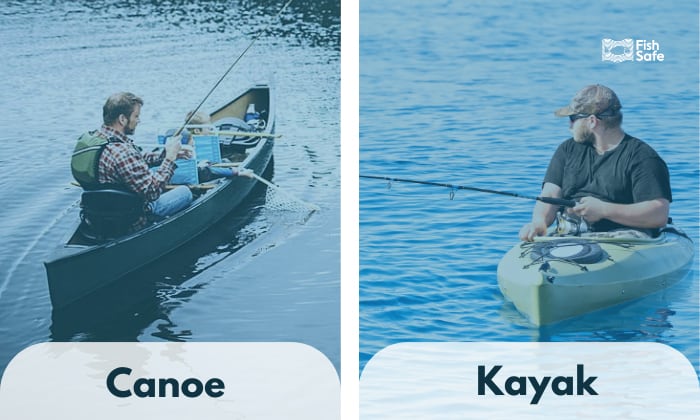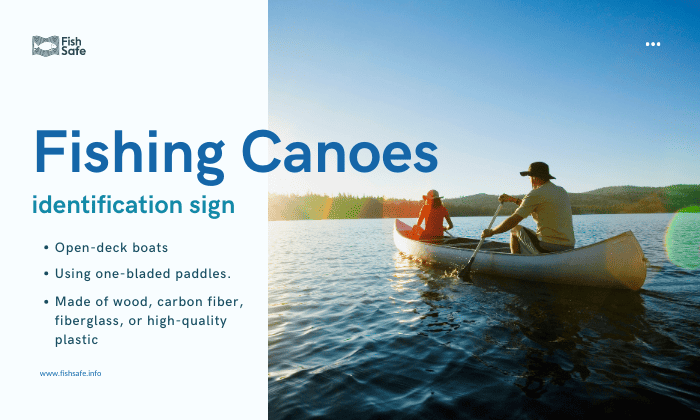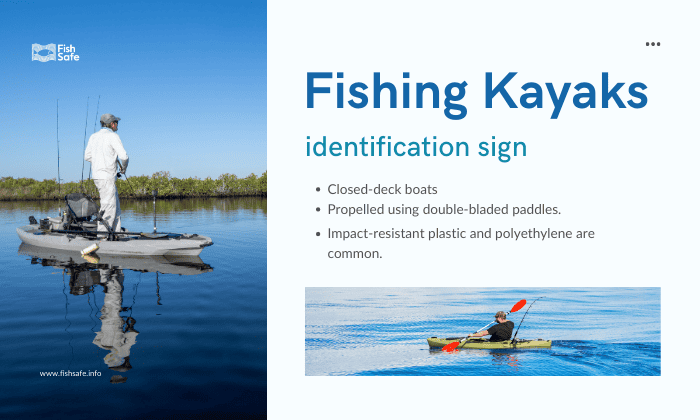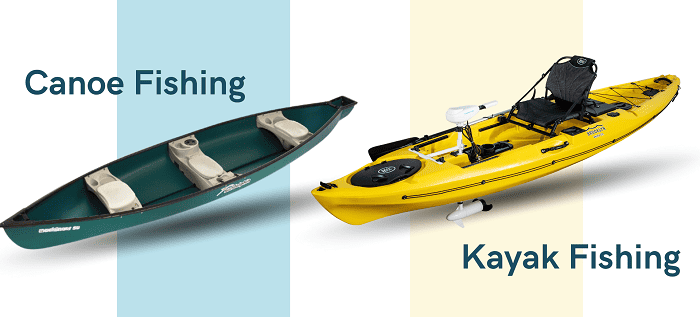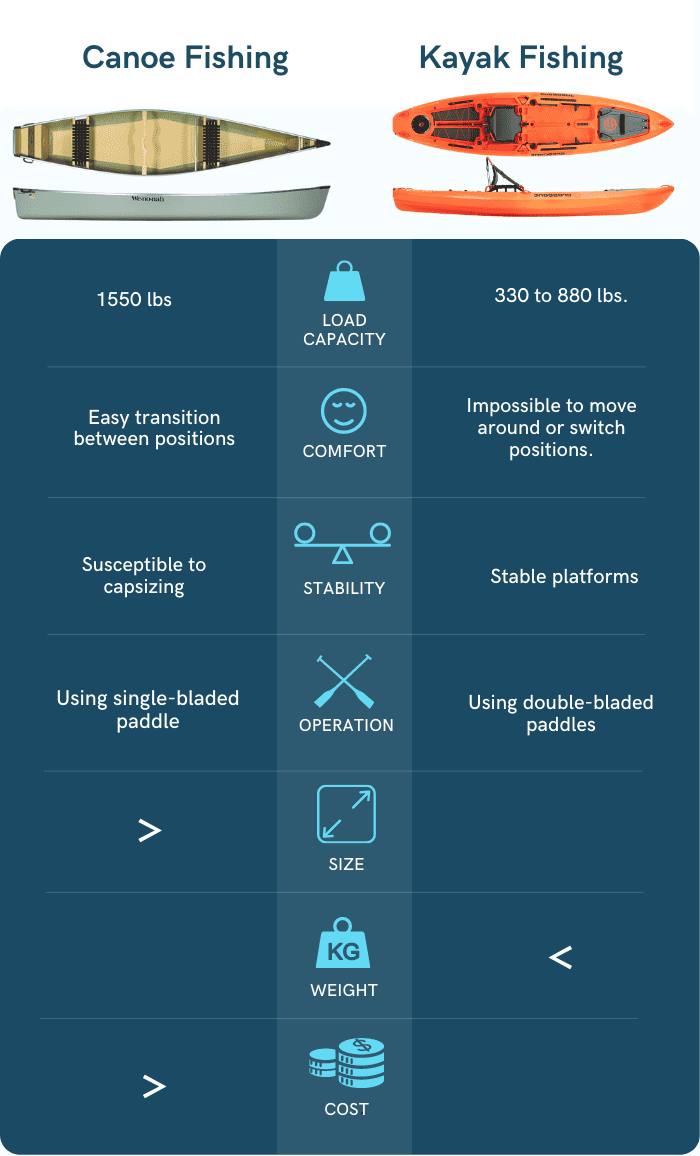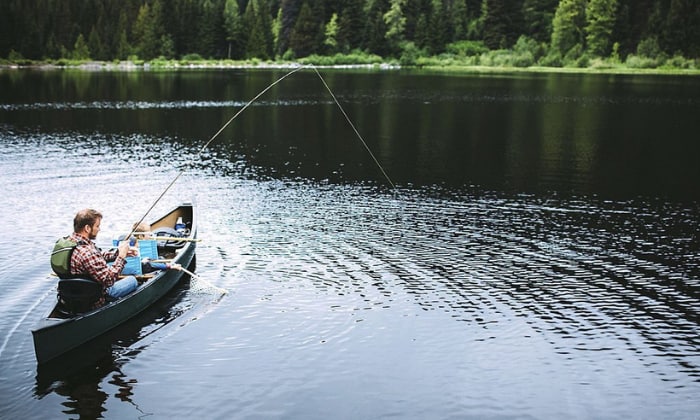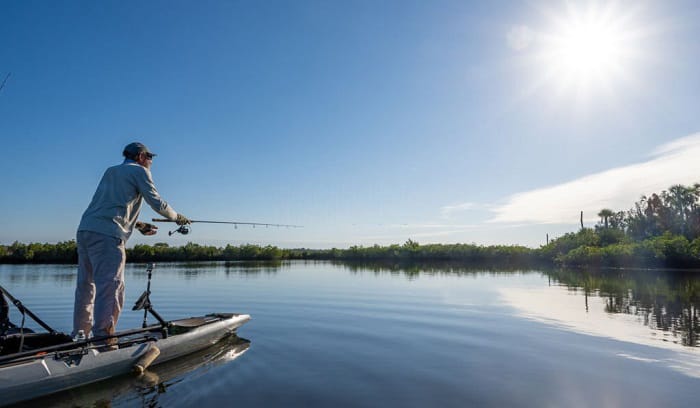A canoe and kayak are two different fishing vessels with their own unique strengths and weaknesses. If you prefer the comfort of a larger boat, a canoe might be right for you. Alternatively, a kayak might be just what you need if you prefer the stealth and mobility of your watercraft.
Still unsure about canoe vs kayak fishing? In this article, we put them head to head, so you can pick the best platform for your fishing pursuit. Keep reading and rowing with us!
To help you decide effectively, here’s a quick look at their key differences.
| Canoe | Kayak | |
| Stableness | Less stable | Much stable |
| Comfortability | More comfortable | Less Comfortable |
| Capacity | More weight capacity | Lesser weight capacity |
| Space | More legroom and storage | Restrictive legroom and storage |
| Capsizing | Difficult to turn over | Easier to turn over |
| Passenger | 2-3 people | Mostly one person |
| Cost | Less affordable | More affordable |
Page Contents
- What Are Fishing Canoes?
- What Are Fishing Kayaks?
- Canoe & Kayak Fishing: Similarities
- Canoe & Kayak Fishing: Key Differences
- Which is Better, Canoe or Kayak Fishing?
- Tips for Choosing the Right Watercraft
- Common Mistakes While Fishing
- Tips for Fishing Effectively
- Safety Tips for Canoe and Kayak Fishing
- Frequently Asked Questions
- Conclusion
What Are Fishing Canoes?
Fishing from a canoe is one of the best ways to get out on the water and enjoy the serenity of nature. You can just sit back and relax as the boat drifts over the lake or ocean, waiting for that perfect moment when a fish bites your bait.
Generally, canoes are small watercraft made of wood, carbon fiber, fiberglass, or high-quality plastic. They are usually open-deck boats, propelled using one-bladed paddles.
The canoe was a favorite for centuries for its ability to load up some people and equipment in large lakes and majestic rivers. In recent years, they have made strides in water resistance, mobility, and robustness, making them an excellent choice for any fishing activity.
The most common types are made of wood, like those from the Old Town Canoe brands. They usually come with a flat or V-shaped bottom and mimic a banana’s shape.
- More space to stash your gear and equipment
- Spacious legroom to stretch your legs or change position
- Good for calmer waters, such as lakes and ponds
- No need to paddle against current or wind directions
- Durable and long-lasting
- A bit bulky and heavy
- Difficult to control and move for beginners
- Not best suited for rough waters
- Inability to stand up when fishing
- Expensive
What Are Fishing Kayaks?
While kayaks are mostly used for watersports (like white-water rapids) and recreation, they’re also a popular choice for fishing. Like canoes, they allow you to fish from the shoreline and narrow areas without having to wade into the water.
Kayaks are closed-deck boats, propelled using double-bladed paddles. They can be constructed from various materials, but impact-resistant plastic and polyethylene are common.
Similar to canoes, fishing kayaks have been around for centuries. They have a long, thin hull and can be either sit-in or sit-on-top. For fishing, sit-on-top kayaks are widely used because they are more stable and allow for standing casts.
- Much more stable and easier to capsize
- Lightweight and has good portability
- Ability to stand up while casting
- Perfect for any type of water condition
- Better maneuverability
- Presents learning curve to novice fishers
- Uncomfortable with prolonged fishing activities
- Less storage
Canoe & Kayak Fishing: Similarities
Canoe and kayak fishing are similar in some sort of ways. For example:
1. Better accessibility to fishing locations
Since they are smaller boats, both can bring you to remote lakes, rivers, and coastal inlets to find promising spots for fishing. In addition, their shallow drafts allow you to get close to fish without scaring them away.
2. Movement
Both require your paddling power to navigate through the waters. If you don’t want to muscle your way, you can avail of a canoe with a motor or attach pedals on a kayak.
3. Usage
Aside from fishing, you can also use a canoe or kayak for recreation and water sports. Both have one or two-person seater models depending on your preference.
4. Accessories
The rising popularity of fishing directly on the water led to the availability of complete kayaks and canoe accessories. In most cases, both vessels have built-in fishing accessories like rod holders and fish finders.
Canoe & Kayak Fishing: Key Differences
Many people assume that canoes and kayaks are similar. Yet, there are some key differences you need to consider when looking to purchase one of these fishing boats. Let’s take a closer look at each one.
1. Load Capacity
If you’re looking for a larger load capacity, a canoe offers more space and flexibility for your supplies and equipment. Its open deck and larger size allow you to load up to 1550 lbs, taking all your fishing gear, and even a friend or two. Be careful with turning over, though.
As with kayaks, they are open but with a lesser carrying capacity of 330 to 880 lbs. Unlike canoes, you can’t bring bulky fishing equipment or lots of supplies. However, they have closed compartments where you can keep your things safe and dry.
2. Comfort
When fishing, a day on the water can be tough on your back. Hence, you want a relaxing and comfortable experience, especially for longer fishing trips.
For some, canoeiing feels more comfortable than kayaking due to the larger space for sitting. They allow you to easily shift between kneeling, sitting, and standing. Its ample legroom also allows you to stretch your legs forward, adding more serenity to your fishing trips.
Meanwhile, kayaks have limited space, making it impossible to move around or switch positions. Some sit-on-top kayaks are comfortable, but their seats can cause discomfort during prolonged fishing.
3. Stability
When you’re out on a fishing trip, you don’t want your boat to flip over. That’s why ensuring your vessel’s stability is essential. Additionally, you may want to stand up to get a more challenging experience out of your pursuit. After all, standing gives you a better vantage point when casting.
Due to their wider hulls, sit-on-top kayaks are stable platforms, allowing you to stand up to cast. Their ability to stay stable in strong currents makes them suitable for choppy waters and saltwater fishing.
On the other hand, canoes are susceptible to capsizing because of their V-shaped hulls. They may be fast and easy to maneuver but are less stable. Hence, they’re more suited to calm waters like gentle rivers, ponds, or lakes.
4. Operation
Canoes and kayaks have varying paddling techniques and means of propulsion. The former is usually propelled by a single-bladed paddle, while the latter is propelled by double-bladed paddles.
Generally, canoes take you more energy to paddle. Kayaks are faster and require less effort to steer through the waters.
5. Storage
Do you have enough space in your garage or home to store your fishing vessel? If not, you need to consider the size of your boat. For example, a solo fishing canoe may be lighter but bulkier than average-sized kayaks.
Moreover, kayaks are usually shorter and narrower than canoes. This gives them better portability, either by hand or in a vehicle.
6. Cost
A new fishing boat can be a big investment, especially if you pick a higher-end model. Luckily, there are countless choices that can fit any budget. Usually, the price depends on the materials used in construction and accessories.
In general, canoes will cost you more. However, if you prefer a hybrid or pedal-drive fishing kayak, it’ll likely cost more. The good thing is that they come equipped with suitable fishing accessories.
Which is Better, Canoe or Kayak Fishing?
Canoe and kayak fishing are two different pursuits of fishing that provide varying experiences. They both require the same amount of skill and preparation.
Which one would be best for you? It boils down to your preference, water conditions, and fishing style.
For some people, canoes provide the ultimate comfort and flexibility. Yet again, if you love fishing and need a boat that can hold up against strong currents, then maybe a canoe isn’t a good idea. After all, that’s where kayaks shine!
Another consideration is your budget. Both types of vessels have varying prices, and the best platform really depends on how much you’re willing to splurge.
At the end of the day, we think it really comes down to your personal preference and needs. The best thing to remember is that fishing is about having fun on the water while doing something you love.
Tips for Choosing the Right Watercraft
Choosing the right watercraft for fishing can be a challenge, especially for beginners. Here are some tips to help you narrow down your options:
1. For Different Fishing Conditions
If you like fishing in different conditions, consider how well a boat can stand up to strong currents. In short, make stability and easier maneuverability a major factor in choosing your watercraft.
As discussed earlier, a canoe fishing boat is best for peaceful bodies of water. Because of its long and heavy design, it’s much tougher to steer in rough seas, streams, and rapids.
In contrast, kayaks can work well in both situations. You don’t have to worry about flipping over in strong water currents.
2. Techniques
Fishing on a kayak or canoe requires different techniques due to their design. When deciding on your watercraft, think about which technique or position you’re most comfortable with.
Basically, kayaks are user-friendly because they’re smoother to paddle and steer. If you’re equipped with the right techniques, canoes are more nimble, too.
For a single person, it will be easier to learn your technique. With a paddling buddy, you need an effective rowing strategy to move fast.
3. Locations
You may also need to consider the different locations you want to go fishing. Both types of boats can reach remote and narrow areas. Still, their respective sizes can limit their access to different parts of the water.
Depending on where you want to go fishing, you may choose a small fishing canoe or kayak. That way, you can sneak even into the tightest areas.
Common Mistakes While Fishing
As a passionate fisher, you should understand everything about this activity, like the gear, bait, and techniques involved. Besides, you need to know the mistakes you might make. Being aware of these things can lead you to a successful fishing adventure.
Some common mistakes may include:
- Not planning ahead
- Using the wrong bait or lure
- Ignoring bad weather conditions
- Not having the proper equipment
- Damaged fishing line
- Tying your line improperly
- Disobeying safety hazards
Tips for Fishing Effectively
Mistakes do occur. However, you can avoid them and fish effectively with these tips.
- Plan and prepare ahead of time
- Check the weather forecast
- Know the fishing rules and regulations
- Bring the right equipment
- Learn different fishing techniques
- Be patient
Safety Tips for Canoe and Kayak Fishing
Whether you’re a novice or an experienced angler, these tips will help make your time on the water as safe as possible.
- Don’t forget to wear a life jacket and have complete safety gear in place.
- Be familiar with various canoeing or kayaking techniques.
- Ensure the weather is good before going out.
- Plan ahead and inform your family where you’re heading.
- Pack enough food and water.
- Bring an extra paddle, in case one breaks or gets lost.
Frequently Asked Questions
Is it hard to fish from a canoe?
Fishing out of a canoe isn’t as tough as you might think. If you know the techniques, it should be easy to practice your hobby.
Are fishing kayaks more stable than canoes?
Yes, due to the design and size, a fishing kayak does not easily capsize as canoes do. Therefore, you can stand up and enjoy the stability of a kayak while fishing.
Is it easier to paddle a canoe than a kayak?
Not, not really. In fact, since the canoe is not that stable, you need more physical effort to paddle a canoe than a kayak, especially if you are a beginner.
Do I need a fishing license to fish from a canoe or kayak?
Some states may require a license for both recreational and commercial fishing. It’s best to check your local laws and regulations before heading on a fishing adventure.
Conclusion
In summary, it’s tough to choose between canoe vs kayak fishing. You can make the best decision when you clearly understand your needs and preferences. Keep in mind that canoes are larger and more comfortable while kayaks offer greater stability and speed.
With the information above, we hope that you can finally choose the best watercraft and start your fishing pursuit. After all, nothing feels better than rowing yourself through nature while fishing at your own pace.

Fishing is an important part of my day-to-day life and a wonderful way for me to bond with friends and family. Whether you fish for recreation, competition, or exercise, I hope you find the guides here helpful. Don’t hesitate to drop me a message if you want further help.


